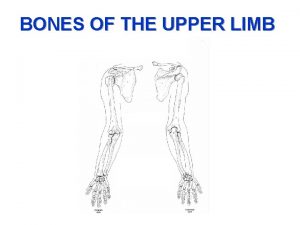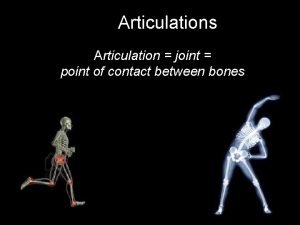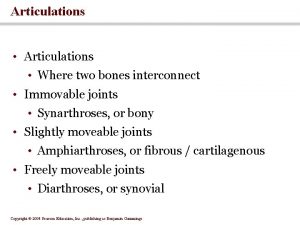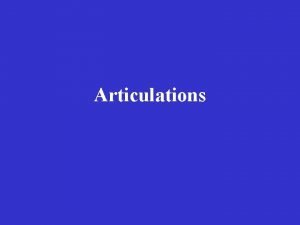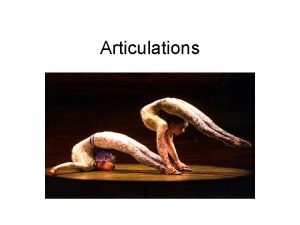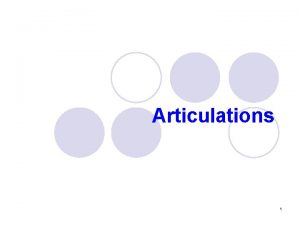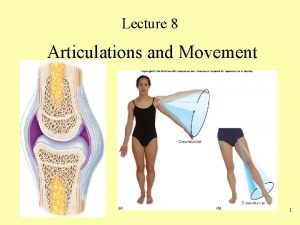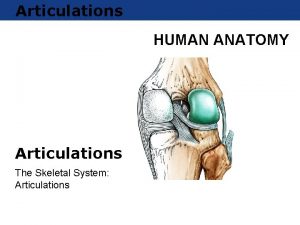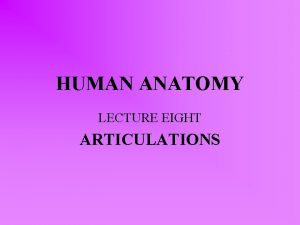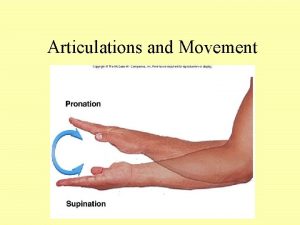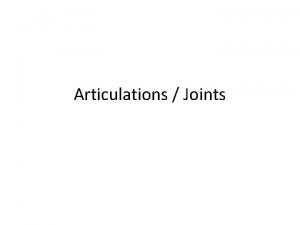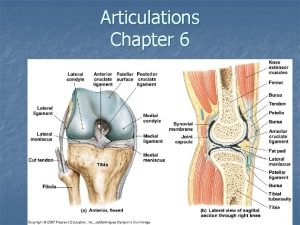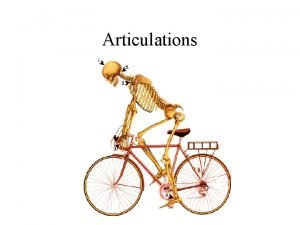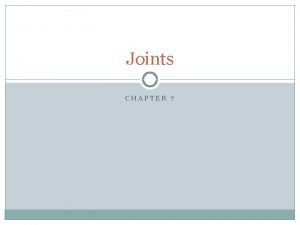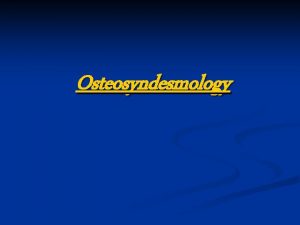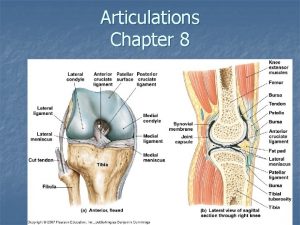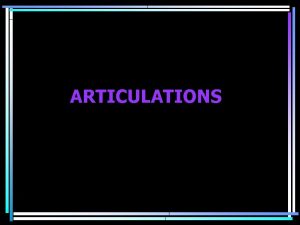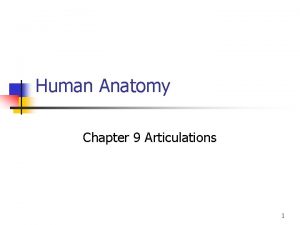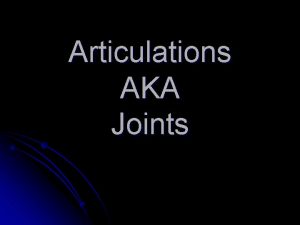Lecture on Articulations www Assignment Point com Functional



















- Slides: 19

Lecture on Articulations www. Assignment. Point. com

Functional / Structural Classification of Joints 1. Synarthrosis (no movement) 1. 2. 3. 2. Bony Fusion (Synostosis) Fibrous (Suture and Gomphosis) Cartilaginous (Synchondrosis) Amphiarthrosis (little movement) 1. 2. Fibrous (Syndesmosis) Cartilaginous (Symphysis)

3) Diarthrosis (free movement) Always synovial joints mono, di-, and triaxial Strength vs. motility The greater the range of motion, the weaker the joint. Dislocation = luxation Partial dislocation = ? “Double jointed”

Diarthroses = Synovial Joints Have synovial cavity = space between two bones Components that are always present (fig 8 -1) Components that are sometimes present

3 Types of Motion at Synovial Joints Linear motion = gliding Angular motion : flexion, extension, hyperextension ab-, adduction circumduction Rotation left - right, internal or medial, external or lateral supination, pronation

Special Movements Dorsiflexion, plantar flexion Protraction, retraction Elevation, depression Eversion inversion

6 types of Diarthroses 1 Gliding Joint 2 Hinge Joint 3 Pivot Joint 4 Ellipsoidal joint 5 Saddle joint 6 Ball & Socket joint

Gliding Joint articulating surfaces flat. • also found between carpals and tarsals • only slight movement - rotation prevented by ?

Hinge Joint Convex surface of bone 1 fits into concave surface of bone 2 found in ? monoaxial

Pivot Joint rotation Projection of bone 1 articulates within ring of bone 2 Also found in proximal ends of ulna and radius pronation and supination

Ellipsoidal (Condyloid) Joint Oval shaped condyle of bone 1 fits into elliptical cavity of bone 2 Also found between phalanges & metacarpals/-tarsals Angular motion in two planes (= )

Saddle Joint Articular surfaces shaped like saddle and rider Modified condyloid joint Extensive angular motion without rotation Also between malleus and incus

Ball and Socket Joint Ball like surface of bone 1 fits into cuplike depression of bone 2 Found in ______ Allows for flexion, ab- or adduction and rotation ( _____axial)

Representative Articulations Temporomandibular Joint Mostly hinge joint, some gliding and rotation Articular disc

Intervertebral articulations Gliding joints between __________ Intervertebral discs: (Amphiarthroses) annulus fibrosus: tough outer layer (fibrocartilage) nucleus pulposus: soft, gelatinous core Account for ~25% of vertebral column height – H 2 O loss during aging Intervertebral ligaments Fig 8 -8

Disc Problems Slipped Most disc vs. herniated disc common sites for disc problems: C 5 - C 6 L 4 - L 5 - S 1 Lumbago Laminectomy ( surgical removal vertebral arch by shaving laminae to access disc) Fig 8 -9

Glenohumeral Joint Type? Greatest range of motion (due to loose and shallow) Most frequently dislocated Stability provided by?

Hip Joint Deep well fitted _______ joint Participants ? Stabilization: Extracapsular and intracapsular ligaments (ligamentum teres = ligamentum capitis femoris) Surrounding Most muscles important normal movement? Fig 8 -15

Knee Joint Much more complex than elbow Much less stable than other ______ structurally Extra- 3 separate joints and intracapsular ligaments Locking of knee due to external rotation of tibia Figs 8 -16 & 17
 Bài thơ mẹ đi làm từ sáng sớm
Bài thơ mẹ đi làm từ sáng sớm Cơm
Cơm Articulation of frontal bone
Articulation of frontal bone Articulations
Articulations Example of synarthroses
Example of synarthroses Articulations
Articulations 01:640:244 lecture notes - lecture 15: plat, idah, farad
01:640:244 lecture notes - lecture 15: plat, idah, farad Removable non functional space maintainer
Removable non functional space maintainer Non functional plasma enzyme
Non functional plasma enzyme Enzymes
Enzymes Functional and non functional
Functional and non functional What is the point of uchendu’s lecture to okonkwo?
What is the point of uchendu’s lecture to okonkwo? Www assignment
Www assignment Slidetodoc.com
Slidetodoc.com Bfr algorithm example
Bfr algorithm example Assignment point.com
Assignment point.com Assignment point.com
Assignment point.com Welcome to our presentation
Welcome to our presentation Www.assignment
Www.assignment Quality management assignment
Quality management assignment



